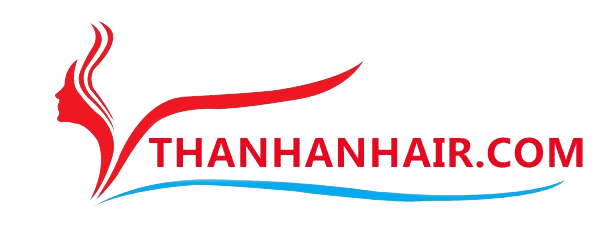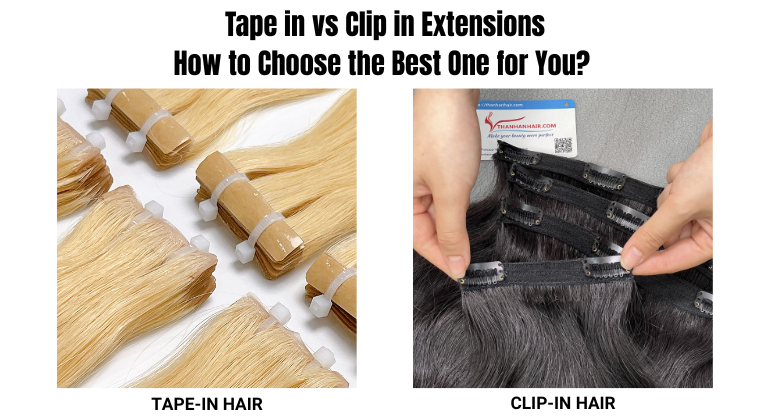Raw Vietnamese Hair
Tape in vs Clip in Extensions: How to Choose the Best One for You
Hair extensions are a fantastic way to add volume, length, and style to your natural hair. Among the most popular types today, tape in vs clip in hair extensions are top choices due to their versatility and accessibility. However, each type comes with its own unique advantages, catering to different needs. So how do you decide which one is best for you? This guide will help you clearly understand the differences between Tape in vs Clip in extensions, so you can make the right decision for your beauty routine.
What Are Tape in Hair Extensions?
Tape-in extensions are a semi-permanent hair extension method. They use medical-grade adhesive tape to attach the extension wefts close to your scalp, blending seamlessly with your natural hair. This creates a smooth, natural finish that is especially ideal for those with thin or fine hair.
Advantages of Tape in Hair Extensions:
- Natural look: Blends perfectly with your real hair and adds thickness – making it nearly undetectable.
- Long-lasting results: Can last 6 to 8 weeks with proper care.
- Comfortable & secure: Suitable for daily wear and even during physical activities.
- Low damage: No heat or harsh chemicals are needed during installation.

Disadvantages of Tape in Hair Extensions:
- Higher cost: Requires professional application and removal to ensure safety and effectiveness.
- Special care needed: Must use suitable products and wash gently to maintain the adhesive strength.
- Not removable daily: May feel heavy or tight at first, which can be uncomfortable for some users.
Best for: Those looking for a natural-looking, long-term solution and who are willing to invest time and money into regular maintenance.
>>> See more: Tape in hair extensions
What Are Clip in Hair Extensions?
Clip-in extensions are a temporary and DIY-friendly option. These wefts come with built-in clips, allowing you to easily attach or remove them in just minutes – perfect for switching up your hairstyle daily or for special occasions.

Advantages of Clip in Hair Extensions:
- Quick and convenient: Easy to apply and remove at home without professional help.
- Budget-friendly: Lower upfront cost compared to tape-in, and no installation fee.
- Style flexibility: Effortlessly change hairstyles to match your mood or outfit.
- Easy to store: Can be removed, cleaned, and safely stored when not in use.

Disadvantages of Clip in Hair Extensions:
- May be visible: Might not blend well if your hair is too thin. Adjustments are often needed.
- Can feel heavy or slip: Especially during workouts or while sleeping. Must be removed before bed and re-secured if you’re active.
Best for: Those who want flexibility, frequent changes, and a commitment-free way to experiment with different styles.
>>>See more: Best Quality Normal Clip In Hair Extensions Raw Vietnamese Hair
Tape in vs Clip in Extensions: Which Should You Choose?
Choosing between tape in vs clip in extensions depends on your style preferences, daily habits, budget, and willingness to maintain your extensions.
- If you’re looking for a temporary solution that’s easy to use for special events or changing styles frequently, Clip in extensions are your best bet.
- If you prefer longer, fuller, and more natural-looking hair for everyday wear and don’t mind regular maintenance or a higher cost, Tape in extensions are the better option.

For salon owners, hairstylists, and hair vendors, having both types in stock is ideal to meet your clients’ varied demands.
Tips to Extend the Lifespan of Your Hair Extensions
The key to getting the most out of your hair extensions is proper care. Below are some tips for maintaining both tape-in and clip-in hair:
How to Care for Tape in Hair Extensions:
- Use sulfate-free shampoo and conditioner to preserve the adhesive.
- Gently brush using a loop or extension-safe brush, avoiding the taped areas.
- Avoid applying high heat near the tape to prevent loosening the bonds.
- Visit a professional for reinstallation every 6 – 8 weeks.

How to Care for Clip in Hair Extensions:
- Detangle before and after use to reduce shedding and matting.
- Store in a dry, closed container when not in use.
- Wash gently with mild shampoo and air dry naturally.
- Limit the use of heat-styling tools to preserve quality and longevity.

Cost Comparison: Tape in vs Clip in
As discussed earlier, tape in extensions cost more due to professional installation and upkeep. But they deliver longer-lasting, more natural results. On the other hand, clip in extensions are more affordable, reusable, and offer flexibility for different occasions – a smart choice for beginners or casual users.
Tape in vs clip in extensions each type of hair will suit each person’s needs in terms of price and usage.
Final Verdict: Which One Is Right for You?
Your decision between tape in vs clip in extensions ultimately comes down to your personal needs, habits, and commitment to maintenance.
- Choose tape-in extensions if you want a long-term, natural look and are okay with investing time and money into upkeep.
- Choose clip-in extensions if you value flexibility, affordability, and ease of use.
Regardless of your choice, both types can transform your look beautifully – as long as you care for them properly and choose the right type for your lifestyle.

If you’re not just a personal user but a salon owner, hair distributor, or professional stylist, choosing a trusted hair supplier is just as important as choosing the right extension method.
Thanh An Hair is always ready to support you with high-quality, ethically sourced hair. With over 13 years of experience in the hair extension industry, a Verified Alibaba supplier badge, and partnerships around the globe, Thanh An Hair is the ideal partner for salons, hair businesses, and stylists seeking premium hair at reasonable prices.

>>> See more: Top 10 Best Wholesale Hair Suppliers in the World in 2025
👉 Contact us today for personalized advice and premium hair extension solutions that suit your business and clients’ needs.




